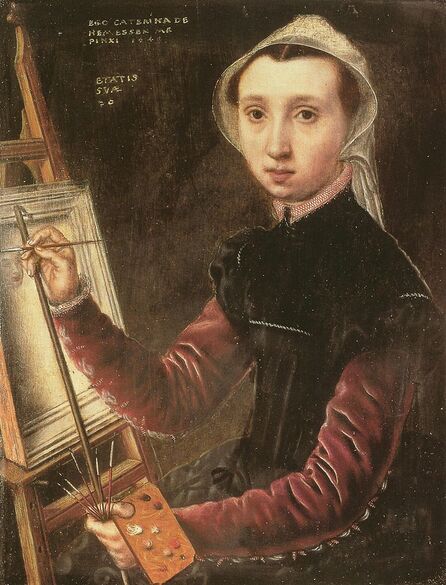|
Where? Kunstmuseum Basel
When? 1548 What do you see? A self portrait of the 20-years old Caterina (also spelled Catharina) van Hemessen. It shows the artist at her easel, working on the outline of a face. She probably looks into a mirror, not at the viewer. She wears the traditional wired head cover (haube) made of fine linen or perhaps delicate cotton that confirms she is at work or may refer to her devoutness. She holds her brushes and palette with the ease and familiarity of an artist. The brushed velvet of her clothing is expensive and proclaims her status and wealth in society. The white of the oak panel on the easel draws attention to the beginning of her drawing. The portrait of herself seems to be a bit out of proportion, with her head and arms appearing relatively larger than what her body suggests. Note also the cross created by her brush in her right hand and the maulstick (rest or steadying stick used when painting) in her left. Perhaps she is equating her painting ability to a gift from God that she is sharing. Van Hemessen has reversed the drawing on the panel from what the viewer sees in the finished portrait to provide a triangle from the unseen mirror, to the brush, to her face. She signed her finished painting: "Ego Caterina de Hemessen me pinxi 1548; Etatis suae 20" which translates to; I, Caterina of the Hemessens, painted me in 1548 at the age of 20. She wanted to be remembered. Backstory: It is one of the oldest self-portraits painted by a woman, but more importantly, she has painted herself seated at the easel. Albrecht Dürer (1471–1528), who died the year Caterina van Hemessen was probably born, painted several portraits of himself and is recognized as an early exponent of the self-portrait genre. Dürer never represented any of the paintbrushes, palette, easel, or even an allusion to his craft. Caterina not only makes it clear that she is a painter, she conveys that she is educated, wealthy, and suggests her religious nature. Caterina's contribution to and development of self-portraiture can be seen in the following years as several of her fellow female artists also eternalized themselves at the easel, including Sofonisba Anguissola (1532–1625), Artemisia Gentileschi (1593–c.1653), Michaelina Wautier (1604–1689), and Judith Leyster (1609–1660).
2 Comments
|
Categories
All
|
- Home
- Blog
-
Museums
- Alte Pinakothek
- Art Institute of Chicago
- Baltimore Museum of Art
- Barber Institute of Fine Arts
- Bargello
- Barnes Foundation
- British Museum
- Church of Sant’Anastasia
- Cleveland Museum of Art
- Courtauld Institute of Art
- Detroit Institute of Arts
- Frans Hals Museum
- Galleria Borghese
- Gallerie dell'Accademia
- Getty Museum
- Guggenheim
- Hermitage Museum
- Kunsthistorisches Museum
- Kunstmuseum Basel
- Legion of Honor Museum
- Louvre
- Mauritshuis
- Metropolitan Museum of Art
- Musee d’Orsay
- Museum of Fine Arts in Boston
- Museum of Modern Art
- National Gallery in London
- National Gallery of Art
- National Museum in Poznań
- Norton Simon Museum
- Ny Carlsberg Glyptotek
- Palace of Versailles
- Palazzo Pitti
- Palazzo Vecchio
- Petit Palais
- Philadelphia Museum of Art
- Prado
- Pushkin Museum
- Ravenna Art Museum
- Rijksmuseum
- San Diego Museum of Art
- Santa Maria delle Grazie
- St. Peter's Basilica
- Städel Museum
- Statens Museum for Kunst
- Tate Britain
- Tate Modern
- Timken Museum of Art
- Uffizi
- Vatican Museums
- Wallace Collection
-
Artists
- Altdorfer
- Anguissola
- Berlin Painter
- Bosch
- Botticelli
- Boucher
- Bronzino
- Bruegel the Elder
- Brunelleschi
- Cabanel
- Caillebotte
- Canova
- Caravaggio
- Carpeaux
- Cezanne
- Cimabue
- David
- Degas
- Delacroix
- De Maria
- Donatello
- El Greco
- Fontana
- Fra Angelico
- Fragonard
- Gauguin
- Gentileschi
- Gericault
- Gonzalez-Torres
- Goya
- Hals
- Hogarth
- Hokusai
- Ingres
- Leonardo da Vinci
- Lippi, Filippo
- Longhi, Barbara
- Lorrain
- Makovsky
- Manet
- Massys
- Matisse
- Merian
- Michelangelo
- Mochi
- Modigliani
- Monet
- Panini
- Parmigianino
- Perugino
- Picasso
- Pisanello
- Raphael
- Rembrandt
- Renoir
- Reynolds
- Rivera
- Rodin
- Rubens
- Scultori
- Seurat
- Steen
- Tintoretto
- Titian
- Toulouse-Lautrec
- Turner
- Uccello
- Van der Weyden
- Van Dyck
- Van Eyck
- Van Gogh
- Van Hemessen
- Vasari
- Velazquez
- Vermeer
- Veronese
- Vigée Le Brun
-
Locations
- Books
- About Us




